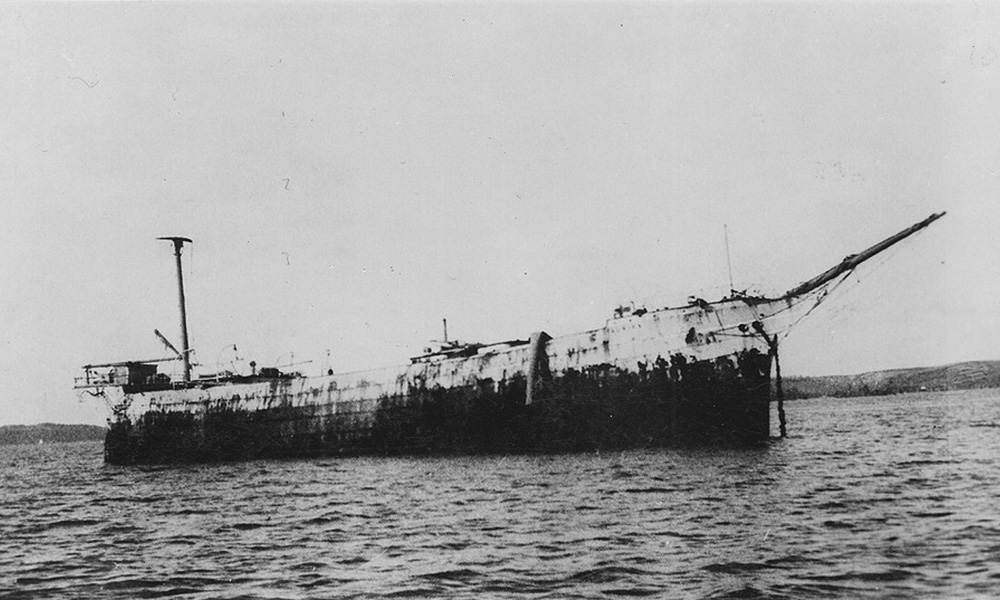IN MARCH 1924 the Daily Commercial News reported that theBritish barque Falkirk dismasted duringa storm. The ship was on its way fromBordeaux to New York to load case oil forSydney and Newcastle.
“The master states that the vessel leftfor Bordeaux on January 6, in ballast, forNew York and ran into heavy weather thenext night, which continued until thefollowing Saturday (Jan. 12),” DCN wrotein its coverage on 3 March.
“At 8.20 p.m. (Jan. 12) a tremendouscross-sea broke over the ship in alldirections, the waves being some 20ft. high. There was a storm of hail andlightning from 6 to 8 p.m. The foremastfell with the rigging and everythingattached,” it wrote.
“Twenty minutes later the mainmastand topmast also went overboard. Themizen mast stood with the topmast,swaying about for 48 hours, but at 4 a.m.on Sunday (Jan. 13) there was a terriblecrash and the mizen topmast fell. Thevessel’s bulwarks were severely damaged bythe spars, etc., banging against the sides.”
It was announced only a few weeksearlier that Falkirk had been “fixed” for thevoyage to Australia. It had been laid up foralmost four years.
“This disaster to the Falkirk is mostunfortunate to the owners, as the vesselhad been lying at Bordeaux since June10, 1921, waiting for freight to improve,so that she could again be placed incommission.”
A MASS OF WRECKAGE
The Dutch tug Roode Zee towed thedismasted barque into Falmouth on 17January. Sydney newspaper The Labor Dailydescribed the ship as “mass of wreckage”after the incident.
“Only the two aft lifeboats and thegalley standard binnacle escaped damage,and when the vessel was secured and towedinto port she was unrecognisable as thestately three-masted barque that had leftfor New York a few days previously,” itwrote in an article on 6 June.
“She was littered with wreckage, andonly the mizen mast remained standing.What remained of the vessel has sincebeen sold, and she will most likely end herdays as a hulk.”
In June 1924 Falkirk was towed toAppledore, England for scrapping. It wasbroken up in August that year.
STEAMER ABANDONED AND SINKING
There was news on the fate of Mary Horlock in the pages of the DCNin March 1924. The British steamerhad foundered in the Pacific whileon its way to Japan, and the crewwas rescued by another steamer inthe area.
“When the crew left the steamershe was in a sinking condition, thecargo having shifted and the coalsupply being exhausted,” DCN wrote.
“The vessel was only in Sydney lastOctober. She loaded a cargo of wheatfor Shanghai, under charter to theAmerican Trading Co., who, when shehad discharged her cargo, charteredher again for a voyage from thePacific Coast to Japan, which hadsuch a disastrous termination.
“The Mary Horlock was under thecommand of Captain Hill, who mademany friends while in Sydney, and forwhom much sympathy is expressedat the loss of his fine vessel.”
The Newcastle Sun wrote that “themost sensational happening” on thevoyage was a wireless message fromthe steamer Baron Blantyre, whichvanished in September 1923.
“The Mary Horlock’s wirelessoperator claimed that the messagewas the last from the missing vessel.It read, ‘Baron Blantyre, from Durbanto Australia, cargo coal, meetingextremely bad weather’,” it wrote.
“The message ended abruptly, and all efforts to communicate further with the Baron Blantyre were fruitless.”
This article appeared in the March 2024 edition of DCN Magazine





